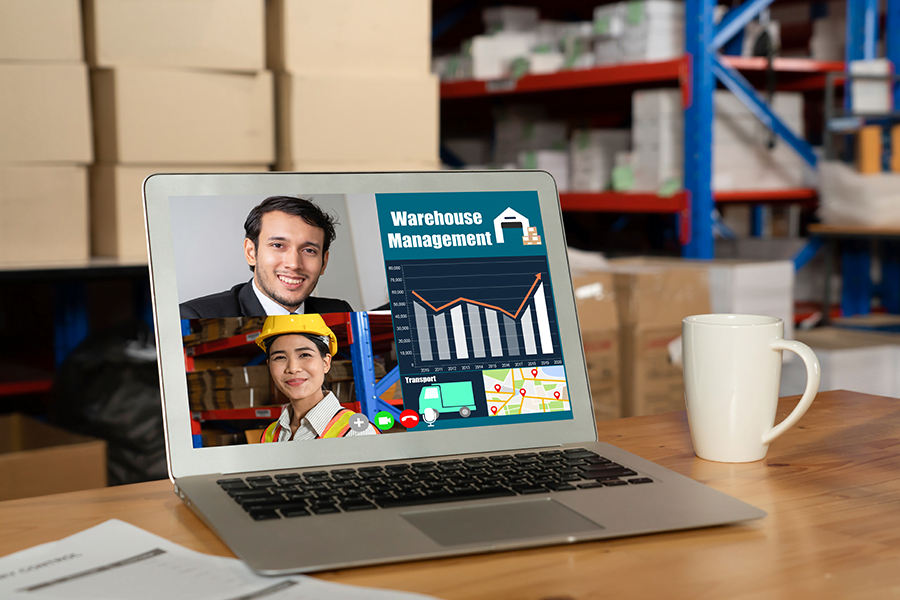Published October 20, 2020
Warehouse management system (WMS) selections and implementations have traditionally been on-site affairs with software vendors, consultants and internal resources spending considerable time in the distribution center (DC) and common conference rooms. The effectiveness of face-to-face communications and interactions has been a key driver behind this method, but context has also played an important role. Seeing an operation firsthand provides a framework for understanding requirements and also simplifies and expedites problem solving.
COVID-19 has thrown a wrench into this working model. While launching a WMS project at a time when facility access and travel should be curtailed may seem like a non-starter, business and technology needs have not stopped because of the pandemic. In many ways, COVID-19 has accelerated the need for an efficient WMS.
So what can be done to change this model while still ensuring success? Here are a few tips for proceeding with a WMS project during a pandemic:
- Leverage remote meeting and streaming technologies. Videoconferencing platforms have become a mainstay in the business world during the pandemic. There is no reason why they can’t be effective in a WMS project, but their effectiveness is greatly enhanced by team buy-in and clearly defined rules. Attendees need to be active and not multi-tasking. Recordings should be made and published.
Live streaming and action cameras can help bridge the context gap generated by not being on the warehouse floor, but effectively supporting an interactive virtual tour requires work. Tours and floor sessions should be approached as the video production efforts they are with proper equipment, sufficient resources, planned scripts and agendas, and rehearsals.
- Rethink scheduling and meetings for a virtual world. Remote videoconferencing provides the opportunity to spread out demo and design sessions in more manageable segments. Consider vendor demonstrations during a WMS selection. On-site demos are frequently booked as all day sessions for each vendor to accommodate travel schedules. This sets the stage for information overload and typically results in vendors jockeying for the last slot. Videoconferencing provides the opportunity to break up demos by topic so team members are not required to digest everything at once. Vendor order can be shifted by topic to help level the playing field.
- Recognize the impact on program management. Relying on remote interactions and activity adds project management workload as more meetings have to be scheduled. Remote working technology has to be managed. Team interactions have to be proactively planned and managed for an environment when popping one’s head into a colleague’s office is not practical. This will place additional burdens on the project’s program management office.
- Build out collaboration tools and repositories. Collaboration tools, project repositories and issue management solutions need to match the remote working environment. Cloud native tools are a prerequisite for success. Assess if existing tools are sufficient to meet the challenges. Make sure that seats or subscriptions are fully funded to meet the needs of the extended team. Recognize that external parties such as vendors and third-party consultants are integral parts of the team.
- Increase local subject matter expert participation. Most organizations recognized the importance of Involving subject matter experts (SMEs) and supervisors in requirements development, testing and training delivery. But recognition and actual results frequently don’t align. This is understandable given the daily operational demands on these resources. Also, there are workarounds in an on-site world such as relying on additional vendor resources and third-party consultants during go-live and stabilization. If this on-site external presence must be limited, then companies must find creative ways of freeing up SMEs and supervisors to support testing and training. This will have the additional benefit of accelerating knowledge transfer for a smoother go-live.
- Focus on visibility within a virtual world context. Leverage cloud-based project tools to build out visibility across the extended project team. Publishing relevant performance metrics in a readily digestible format is a great way to promote team identity in a remote working environment.
- Make safety a key factor when on-site presence is required. Some on-site work may still be required. If so, it needs to be done in a safe and effective manner. Travel should be planned to maximize what can be done in a single trip. Team members that have high COVID-19 risk profiles should be exempt from travel. When travel and on-site presence are required all safety protocols should be followed.
Once the pandemic is firmly in the rear-view mirror, it is doubtful that most WMS projects will return to the old on-site operational mode. The movement towards more off-site participation was already in the works prior to COVID-19, spurred on by cloud-based collaboration tools and the desire to reduce travel costs. Any investment in embracing this project model will continue to pay off once the pandemic is history.
This post is part of our blog series on WMS implementation. Learn more about this topic in the related articles below or visit our newsroom to stay up to date on our latest news.



